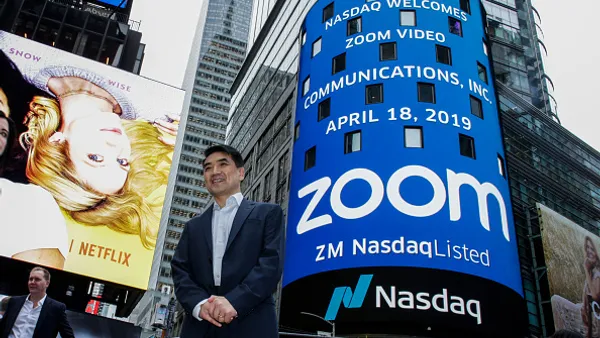People managers are disengaged, and it's negatively affecting the entire workplace.
The effect? Poor engagement and employees toying with attrition. Despite the turbulent economic landscape, 46% of professionals still say they're considering quitting in the year ahead, putting not just people managers’ success on the line but companies’ success, too.
“People managers are the most disengaged and burned out of any employee population … and their energy and outlook is contagious,” says Jackie Insinger, bestselling author, leadership consultant, and keynote speaker, in a recent podcast interview with Dr. Matt Poepsel, PhD, the vice president and Godfather of Talent Optimization at The Predictive Index (PI).
“Everybody has one foot out the door,” Insinger adds. She often hears people managers saying, “I'm not looking actively, but I'm open” or “I'm not actively looking, but I've updated my resume.”
Disengagement is a problem, but there are solutions. Below, we provide three from our expert duo’s conversation so you can avoid losing talent and engagement.
Tip 1: Give leaders a reason to engage.
Too many people managers can’t succeed because organizations don’t offer a way to calculate success. One-third of organizations do not have a formal way to measure the success of people leaders (i.e., a rubric), and nearly one-third of organizations do not consistently measure people leaders’ success, according to a recent survey by PI and HR Dive’s studioID.
“When you don't have a definition explicitly of what leadership success looks like, then you're just fumbling around in the dark, overwhelmed, super busy, not knowing if you’re making a difference or not,” Poepsel explains.
At a time when disengagement is at a nine-year high, “The only thing that matters is that leader's version of success,” Insinger adds. But if they don't know what success looks like, how can you expect them to pursue it?
By formalizing what success looks like in your organization, you provide employees with a clear reason to engage, a boon at a time of mass disengagement. Plus, having a formal way to measure success enables the entire organization to succeed, with PI’s data showing that 94% of organizations with formal frameworks find them helpful. “A lot of people think being clear on expectations feels like micromanaging, and it's not,” says Insinger.
Put this tip in practice:
- Establish a formal rubric. (See how PI Perform measures employee performance daily.)
- Use it consistently by going beyond annual reviews with a mix of formal and informal reviews.
- Update it regularly by aiming for an update every 11 months—at minimum.
Tip 2: Make meetings meaningful.
When meetings aren't great, they’re not great for business. Meetings that lack meaning have been shown to lead to disengagement, distraction, and discouragement.
Unnecessary or unproductive meetings also increase employees’ workload at a time when one in four people managers (24%) say that work overload is one of the most significant challenges impeding their success, according to the survey results.
One reason for this that Insinger sees frequently with her clients is if somebody has an opening on their calendar, people assume they're available, making any once-empty space a potential meeting time vs. potential work time.
When managers spend over 50% of their week in meetings, there’s clear room for improvement. By making meetings more effective, you can give people managers time back while improving their productivity and overall job satisfaction in the process.
(Let’s just say there’s a reason the below phrase has become one of the most common memes, even gracing candles and coffee cups.)

Put this tip in practice:
- Encourage people managers to block off focus time.
- Create psychological safety so people feel comfortable enough to reject unnecessary meetings.
- Provide actionable takeaways from meetings (such as with PI Perform’s guided in-meeting experience).
Poepsel suggests that you can make meetings more meaningful by using them as a developmental opportunity. Is there somebody on your team who can represent you in a meeting as a career growth opportunity?
Tip 3: Enable leaders to foster well-being.
Over eight in 10 workers are at risk for burnout this year, and people managers aren’t exempt. The survey showed that 23% of people managers identify the risk of burnout as a significant challenge to their success.
Stressed-out employees are more likely to experience anxiety and disengagement in the workplace, which can eventually lead to burnout.
Burnout doesn't just affect individuals, either; it has a ripple effect on team dynamics. Research shows that team-level burnout and work engagement are closely linked to individual team members’ burnout and work engagement.
Conversely, the link between worker well-being and productivity is well-established. Yet only 10% of organizations prioritize promoting healthy work-life balance as a key criterion for successful people leadership. What gives? It’s high time to give people managers more support for their well-being.
Put this tip in practice:
- Empower leaders to use mental health benefits, and model using them yourself.
- Track how well-being affects project success, and incentivize teams with high well-being.
- Determine what hinders well-being by using tools like PI Diagnose to send pulse surveys measuring employee sentiment toward their roles, managers, teams, or organizations.
One common pulse-survey learning is that employees don’t feel connected to their company’s purpose, negatively impacting their well-being at work.
In these cases, Poepsel suggests asking yourself, “How do the tasks you do every day ladder up to this bigger purpose to give you that sense of meaning, significance, and purpose that Millennials and Gen Z crave to stay at their job?”
Engage with solutions
You want to retain your people managers and keep them engaged, but you also care about them as human beings, and you want to support the whole self they bring to work. Doing so takes understanding what’s blocking their way from doing their best, feeling their best, and thus, achieving success.
Download our free survey report to discover how you can solve your people managers’ biggest workplace struggles to get them from checked out to checked in.










